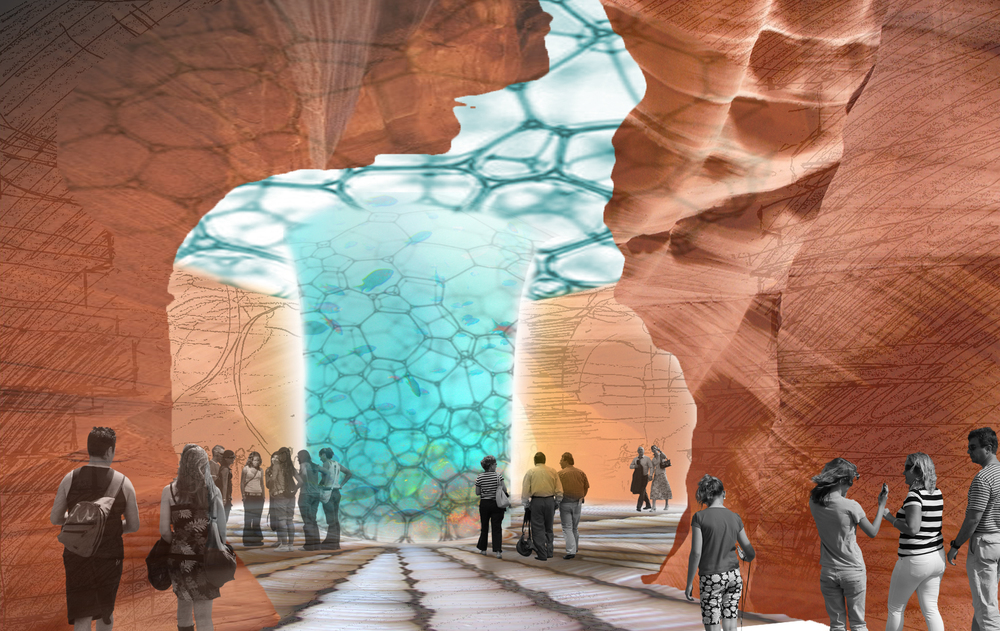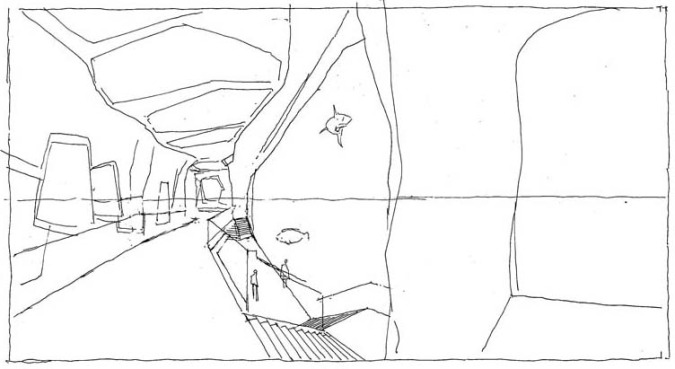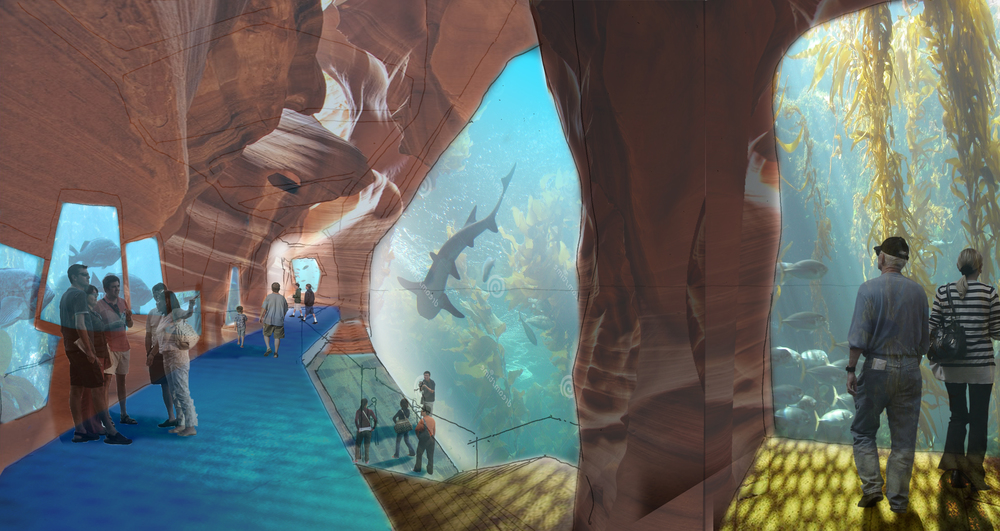Once you add this extension (or lab feature) to your gmal settings, this amazing code runs quietly in the background to pull a copy of every image you have either sent or received in gmail, going back to the beginning of your gmail life. What's more, it automatically collects these images in a folder you can later find in the left column of your (Mac) finder window (see image below). Its kind of a miracle.
Why Can't Architects Give Google-Like Design Test to Job Applicants?
The following is an imaginary interview between a design magazine and an architectural office manager.
DZ: How did the idea of a Google-like, pre-hiring design test come to you?
LG: We were having difficulty determining applicants' real-world ability from portfolios and references alone, so we thought: Why not an on-the-spot "design skill" test? If we're impressed, we find a place for them. If they don't live up to the promise of their portfolio, we invite them to apply again after a spell, and everyone is spared the cost of a sub-optimum hire
DZ: What are those costs?
LG: Time wasted hiring, having to teach, being distracted by, then having to replace the wrong person. Many people and projects are impacted adversely by a sub-optimum hire.
DZ: How did hiring work before the test?
LG: In practice, we rarely had time to follow up on references or determine an applicant's true abilities--or the true contributions they made to projects in their portfolios. The design test helps us identify hidden gems and weed out those who pad their resumes.
DZ: Why do applicants take your test with pencil and paper. Are these relevant in the age of Rhino, CAD and photoshop?
LG: Its simple practicality: pencil on paper is direct, requires no plugs or wifi and provides a record of an applicants design process and ability to tell a story. Its the ability to imagine and communicate that we, and ultimately our clients, are interested in.
DZ: What if a person is brilliant but doesn't draw well?
LG: I want to make a critical point here. We don't care if their drawings are pretty. We're looking for their ability to think critically, design, and communicate.
DZ: Have you lost any recruits because of the test...the intimidation of it?
LG: On the contrary, many of our recruits say they went out of their way to apply for a job at our firm because of the test--because they thought the test was kind of an equalizer that allows them to demonstrate their abilities and not just where they've gone to school.
DZ: How did you devise the test in its present form?
LG: We interviewed all of our principals and asked them what skills they wanted in new people on day one and what skills were missing most. We then invented questions that addressed these issues.
DZ: How do you score the test?
LG: We don't think of it as scoring because there are no right or wrong answers, only thoughtful and less thoughtful ones. The test is kind of fun to look at, as you can imagine
DZ: We liked the question where you had a person invent 3 new ways to clean a toilet. Have the responses been interesting on that one?
LG: We're doing our next book on just the responses to that question."
DZ: But seriously, why give architect applicants the same question as product design and interior design applicants?
LG: I'll get in trouble for this with my fellow architects, but the traditional architect's snobbery about interior design being beneath them is one of the leading causes of poor teamwork at our firm. Its all design, and showing contempt for these other disciplines shows you don't pay close enough attention to your own everyday experience."
DZ: If its not giving too much away, tell us your favorite question.
LG: I like the one that says, "On one page, use diagrams and a maximum of 144 characters to explain the last project (not just your part) to which you contributed at your previous firm. Then tweet your answer to us.
DZ: So has your test helped with hiring?
LG: It's helped us grow our pool of applicants; it's helped identify people we wish to immediately hire, and in more cases than I'd like to say, it's saved our firm perhaps $100s of 1000s of dollars hiring, teaching, then replacing people who lacked a basic understanding of plans, sections, and elevations.
DZ: Thank you, LG.
LG: My pleasure.
Against All Odds, Architectural Rendering By Hand is Back
Ever-shrinking architects’ fees combined with developer’s expectations of Hollywood-quality digital renderings have brought us full circle: hand rendering is being rediscovered as the most cost effective and artistically direct way to do concept design in the digital age, with the added benefit of helping to art-direct third party digital rendering consultants.
iPhone Won't Charge? Here's An Instant Fix That Architects and Illustrators Use .
Storyboards For Startups
Simple Residential Designs for Surprising Solutions
Architectural Rendering Technique: The Art Of The Pen and Ink Sketch
Basic Social Media Tasks Architects and Designers Should Be Doing So As Not To Lose Potential Clients
Product Design Sketching Techniques: Using Photoshop to Recreate Blueprint "Feel"
Architectural Presentation Techniques: The Art of the Digital Sketch
In yesterday's post about loose architectural sketches, we talked about traditional pencil and pen-and-ink sketches. Today we'll talk about what I call a loose digital sketch. The loose digital sketch begins with a loose manual sketch composing the view and identifyling the important elements in the proposed design.
But then the loose digital sketch takes a turn to photoshop.


Working closely with the designer, the architectural renderer...
Architectural Rendering Technique: The Art Of The Loose Sketch
Even in this digital design age, there is a place for the loose architectural rendering. It is fast where other architectural rendering techniques are slow. It is non-commital, where digital rendering has to be precise in order to look good. It's also not a bad metaphor for life. What do I mean by that?
 Loose architectural renderings and sketches are still one of the most important architectural rendering techniques. In this example, the author uses felt tip pen to work directly on top of the soft pencil sketch used to visualize the space and develop the design before the architect's eyes. This insures that the sketch stays loose and that one's attitude toward the rendering does not become too precious.
Loose architectural renderings and sketches are still one of the most important architectural rendering techniques. In this example, the author uses felt tip pen to work directly on top of the soft pencil sketch used to visualize the space and develop the design before the architect's eyes. This insures that the sketch stays loose and that one's attitude toward the rendering does not become too precious.
I mean, how many times in life is 75% or even 85% of the idea...
Pencil Sketching is the New Computer Aided Design
As digital modeling and architectural digital rendering continue to chnage our industry for the better, the arts of architectural rendering and architectural sketching in watercolor, pencil, and pen-and-ink become huge asstes in the constant battle to stand out among competitors all using the same digital tools.
 Architectural sketching and storyboarding in watercolor
Architectural sketching and storyboarding in watercolor
They engage clients' emotions, connecting with that deep thing that persists in all of us--that ability to...
Architectural Sketching and Rendering For The Digital Rendering Age
 Above: This architectural sketch (or what some might call an architectural rendering) in pencil shows the architect's design concept for an underground book storage addition to the Princeton University library. Visualizing the design concept in quick pencil sketches not only engaged the client in an attention-grabbing ad humanistic way, it also served as a kind of art direction to help guide the third party architectural digital renderers.
Above: This architectural sketch (or what some might call an architectural rendering) in pencil shows the architect's design concept for an underground book storage addition to the Princeton University library. Visualizing the design concept in quick pencil sketches not only engaged the client in an attention-grabbing ad humanistic way, it also served as a kind of art direction to help guide the third party architectural digital renderers.Ahh the Smell of Pen and Ink Architectural Rendering in the Morning
Pen, ink and tracing paper remains one of the effective forms of architectural rendering ever devised, but what if we combined it with photoshop and a digital aesthetic?




This architectural rendering project was a lot of fun, done right in the architect's office with close collaboration between architect and architectural illustrator. I would love to know what you think? Please leave coments below.
(The author is a registered architect and architectural illustrator with years of experience helping architects and interior designers develop and present their ideas in dramatic and cost-effective ways. From concept design to final presentation, we work in your office or from our NYC studio. 413-250-8800.)
Drawing and Watercoloring For Architects (A Proposal For Grads New and Not New Who Lament The Loss Of These Skills)
At every office I work with, it seems that fewer and fewer new architectural grads have an opportunity to use their (often VERY impressive) traditional drawing and watercoloring talents. There's nothing inherently bad about the fact that few of us need any longer to draw in our day jobs, or that unprecedented computer possibilities have displaced the need for these skills, but still...I wonder if some future Stanford brain scientist might discover that the profession-wide loss of these skills turns out to have been the loss of something deeper?

Like the ability to rotate imaginary objects and spaces in our heads, or...
A Year-End Thanks To You, Reader, And Your Picks For This Blog's Best Posts of 2015
It’s day three (or is it four? I’ve lost count) of the approaching 2015 year-end holiday season. You’re getting sick of reading the same old online sites: Huffpo, NYT, Fox News, what’s the difference? Why not take a break and read what you voted for as this blog's Best of 2015? And don't forget to join the discussion by leaving your comments!
With humble gratitude for your attention, I give you: the best of the 3-D Visualization Blog, 2013
The Best Ways The Digital Revolution Changed My Life-Part One
If you went to architecture or environmental design school back in the day (when you had to use punch cards to enter data into a room-sized computer), you have witnessed the great shift from analog to digital in the design industry. You’re also old enough to have begun taking for granted the many ways the digital revolution changed our professional lives.
As 2013 draws to a close, seems like a reasonable time to share a personal list of “best ways the digital revolution changed my professional life.” Since I tend not to use CAD--arguably the tool that has had the most influence--my list will be different from yours, but please add your own list in the comments section below. (And no, you don’t have to be an architect to play along.)
 Jimmy Stewart, from that famous movie
Jimmy Stewart, from that famous movie
So here we go: my list of the best ways the digital revolution has changed my life:
-
The internet. Thank you, Tim Berners Lee. Thank you, DARPA (although you also brought us the NSA. Why does every sword have to be double-edged?). Let’s just agree that the internet is the background noise of the new universe described below.
-
Email. The reigning game changer. Email could have retired after killing the fax machine (bonus points if you knew “fax” was short for facsimile) but it didn’t. It just kept getting better...
Pitch Your Schematic Design Ideas With Digital Sketches, NOT Digital Or Traditional Architectural Renderings
Presenting schematic architectural and interior design ideas to your client in the digital age can be challenging. The problem? The photo-literalism of digital images can, if presented too early, elicit an equally literal response in your client and put the organic “Concept-to-DD-to-CD” design process at risk.

Like all technological advances, digital architectural rendering presents us with a double edged sword. On the one hand, digital software gives designers the unprecedented power to present schematic design ideas as photorealistic fait accompli. On the other hand
Use Digital Architectural Sketching To Streamline Client Approvals
It's one week before your next big design meeting. You have multiple ideas to present, but your goal is to secure your client's approval of a single direction so you can complete this phase, bill for it and move your team on to the next.

Back in the day, architects solved this problem by presenting loose architectural sketches (with maybe a little color thrown on them), blown up several feet wide so as to wow the client with vagueness...but times have changed and clients have changed with them.

Modern clients have grown up in a world of photo-realistic digital images.Their parents understood that hand drawn sketches and diagrams were a part of the design development process, but this generation has
Architectural Rendering Techniques: Painting an Architectural Elevation in Watercolor
The world of architectural rendering is changing...or is it? Even in this digital age, architectural renderings need to communicate a specific design while delighting the senses. Whether you use digital architectural rendering techniques or traditional architectural rendering techniques to do that, I hope you enjoy this post documenting the techniques I used creating a traditional architectural rendering in watercolor made for the Yale School of Music (as a gift to the donor giving the funds for the addition at the left of the original building in the photo below).
 This is my current set up: computer for email, image research and Pandora; watercolor palette and old school drawing implements, bookshelves and sideyard beyond
This is my current set up: computer for email, image research and Pandora; watercolor palette and old school drawing implements, bookshelves and sideyard beyond
With your permission, I'll keep words to a minimum and let the images speak for themselves.












